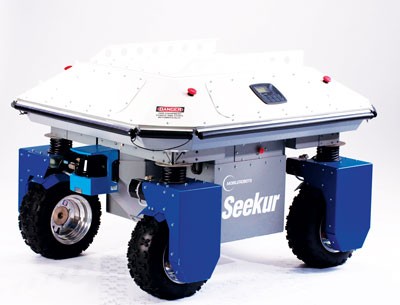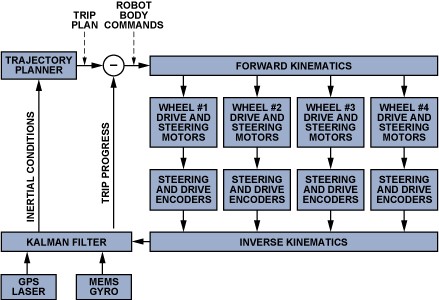Seth Allen, project manager at Adept MobileRobots, believes that ground robot systems must often handle "boring, dirty, dangerous" work. In other words, robotic systems are often used for manual interventions that are too costly, dangerous, or inefficient. In many cases, the autonomous working ability of the robot platform is an extremely important feature that monitors and controls the movement of the robot from one position to the next through a navigation system. Managing position and motion accuracy is a key factor in achieving efficient autonomous operation. MEMS (Micro Electro Mechanical Systems) gyroscopes provide feedback detection mechanisms that are useful for optimizing navigation system performance. The Seekur robot system shown in Figure 1 is an autonomous system that uses advanced MEMS devices to improve navigation performance. figure 1. Adept MobileRobots' Seekur system. The movement of the robot usually begins when a position change request is made by a central processor that manages the overall task progress of the robot. The navigation system begins to execute a position change request by making a trip plan or trajectory. The itinerary plan needs to consider available paths, known obstacle locations, robot capabilities, and any related mission objectives. (For example, for a specimen delivery robot in a hospital, delivery time is critical.) The trip plan is fed into the controller , which generates the drive and direction profiles for navigation control. These profiles perform actions and processes based on the trip plan. The motion is typically monitored by a number of detection systems, each of which produces a feedback signal; the feedback controller combines and converts the signals into updated schedules and conditions. Figure 2 is a basic block diagram of a general navigation system. figure 2. General navigation system block diagram. The key steps in developing a navigation system begin with a thorough understanding of each function, with particular emphasis on its work objectives and constraints. Features often have some well-defined and easy-to-implement factors, but they also raise some challenging limitations that need to be addressed. In some cases, this may be a process of iterative testing, which identifies and addresses constraints while introducing new opportunities for optimization. This process can be clearly illustrated by an example. The Adept MobileRobots Seekur2 is an autonomous robot using the Inertial Navigation System (INS), see Figure 3. The vehicle has a 4-wheel drive system with independent steering and speed control for each wheel, allowing for flexible movement of the platform in any horizontal direction. This capability is useful for robotic vehicles in emerging applications such as warehouse delivery systems, hospital specimen/refill delivery systems, and military reinforcement systems. image 3. Adept MobileRobots Seekur navigation system. The robot body command, the primary error signal, represents the difference between the trip plan provided by the trajectory planner and the trip progress update information provided by the feedback detection system. These signals are fed into a reverse kinematics system that converts the robot body commands into steering and speed profiles for each wheel. These profiles use Ackerman steering relationships to perform calculations that integrate tire diameter, surface contact area, spacing, and other important geometric features. Using Ackerman steering principles and relationships, the robotic platform described above creates an electronically linked steering angle profile similar to the mechanical gear-to-rack system used in many automotive steering systems. Because these relationships are integrated remotely, there is no need to mechanically link the axles, thus helping to minimize friction and tire slip, reducing tire wear and energy loss, and achieving simple mechanical linkages that cannot be completed. . Each wheel has a drive shaft that is mechanically coupled to the drive motor through a gearbox and coupled to the optical encoder through another gearbox, the input of the range feedback system. The steering shaft couples the axle to another servo motor that is responsible for establishing the steering angle of the wheel. The steering shaft will also be coupled through a gearbox to a second optical encoder, the other input of the range feedback system.
As the structural support and optical signal transmission pathway and medium, flexible substrates are playing ever-increasingly important roles in advanced optoelectronic display devices. The use of flexible substrates will significantly reduce the weight of flat panel displays and provide the ability to conform, bend or roll a display into any shape. Moreover, it will open up the possibility of fabricating displays by continuous roll processing, thus providing the basis for cost-effective mass production. Flexible substrate mainly used in thermoelectric refrigerator accessories, high-end car seats, car cold cup, car refrigerator, head display, car power, home appliances, medical devices, semiconductor chips, laser projection, optical device packaging in optical fiber communication and other fields.
Currently, there are mainly three types of candidates for flexible substrates: ultrathin glass, metal foil, and plastic (polymer) films. The raw material use for our flexible substrate is PE base double-sided copper clad with 0.3mm thickness. We are equipped with professional metal etching equipment and exposure development equipment. We use fine etching process and manufactures, we can guarantee that our etching flexible substrate can achieve double-sided etching of different graphics, alignment, neatly arranged, and no shedding, no incomplete, no pores, no inclusions and other appearance defects.
Etching Flexible Substrate,Double-Sided Etching,PE Base Double-sided Copper Clad Flexible Substrate SHAOXING HUALI ELECTRONICS CO., LTD. , https://www.cnsxhuali.com
Robot navigation overview

Adept MobileRobots Seekur robot

Positive control
Wheel drive and steering system